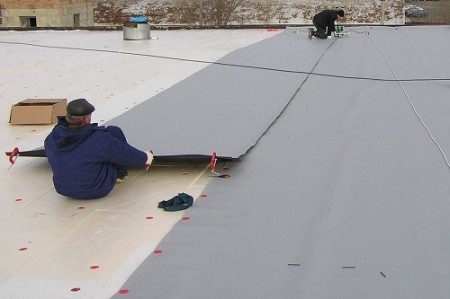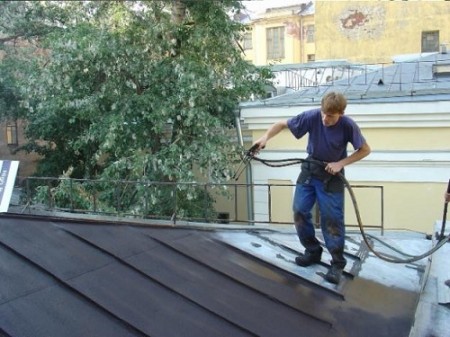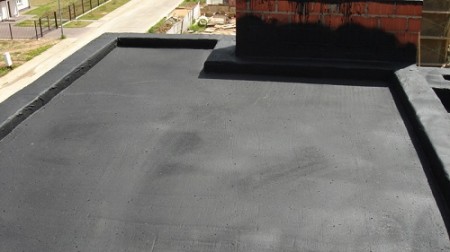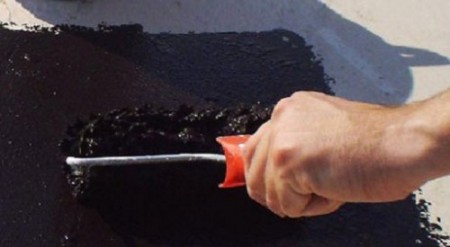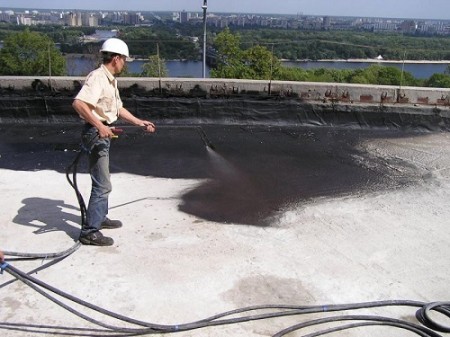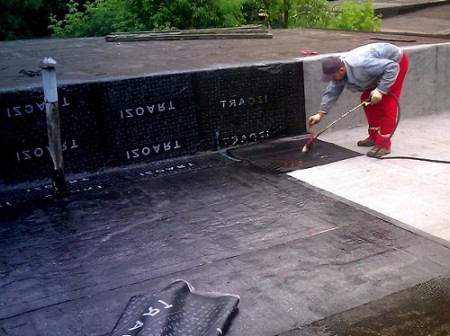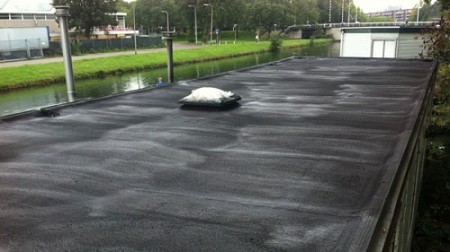A roof is considered to be flat, having a slope of not more than 12 degrees. To make the most reliable waterproofing of the flat roof, often used materials produced in rolls. They are glued to the entire surface of the roof. There is also the so-called liquid roof waterproofing, which is done with the help of liquid rubber, or in other words, a continuous mastic layer is applied.
Content
Materials for the waterproofing of flat roofs
All waterproofing materials used for flat roofs are divided into:
- Mastic.
- Membranes from polyvinylchloride.
- Roll-welded.
- Polymer-bituminous.
More recently, the most affordable and popular waterproofing material was ruberoid. But today it is replaced by more reliable, convenient and relatively inexpensive competitors. Polymer-bitumen materials are in good demand. They are elastic and at the same time have a strong reinforcing base.
Liquid rubber
This method of waterproofing a flat roof has been applied relatively recently. It is considered one of the most profitable, if the roof has a large area. With liquid rubber it is convenient to work if there are, say, parapets on the roof, any protrusions, antennas, ventilation pipes, etc. In this case, the installation of the waterproofing on the roof takes place by means of a cold spray. After a while, the material dries, while very firmly adhering to the surface. The solidified material looks like a solid rubber-like coating.
Liquid rubber has a number of undeniable advantages:
- The material is very durable, elastic, flexible, eco-friendly.
- With rubber it is more convenient to work than with roll materials.
- Liquid rubber is completely waterproof.
- Long service life, more than 30 years.
The entire process of applying liquid rubber to the substrate is divided into several stages:
- Substrate preparation.
- Priming of the foundation.
- Surface reinforcement.
- Spraying of the material.
If it is planned to repair the flat roof with liquid rubber, then it is necessary to prepare the base very carefully, since when using this material it is not allowed to have any dust, dust, leaves on the base.
How best to clean the roof of the garbage
The compressor is most often used for this purpose. Before starting work on the edges of the roof install protective shields to the dust blown to the middle of the roof. It is highly desirable that the compressor be equipped with a separator of oil and moisture, since the base for liquid rubber should be dry and clean. It is necessary to very carefully clean all joints, slots, places where different equipment is attached. Such areas are cleaned with metal brushes by hand or with a drill and a special wire nozzle. Smooth parts of the roof are easier to clean. You can simply rinse with a jet of water under pressure using a washing machine. Naturally, the base should be thoroughly dried after this. But if the roof already has an old roll coating, then the washing can not be used, because under it can get water.
In the case where the liquid rubber is applied to bare concrete, the cement milks are removed from its surface by grinding. In this case, grinding machines for concrete are used. If it is not possible to use the tool, then at least the surface of the concrete is treated with grinding brushes.
What is priming and why is it necessary?
This process is the application of a thin layer of component "A" of liquid rubber. This allows you to create a reliable grip with the base, as well as collect the smallest particles of dust.
Spraying of liquid rubber
The process itself does not represent anything complicated - two types of liquid are sprayed, an activator and a bitumen-polymer emulsion. In the process of spraying, they, mixing together, form a uniform composition, which is a liquid rubber. In the process of drying, the base of the roof turns black. This means that the process is proceeding correctly, and the formation of a seamless membrane has begun.
Waterproofing the roof of the garage with your own hands
Probably, all the owners of garages at least once faced with such an unpleasant phenomenon as a leaking roof, and some are forced to patch "holes" almost every year. Avoid all these troubles will help a good roof waterproofing. The problem can be solved independently or attract professionals. We will briefly consider the first option. But first a little theory.
The most common types of garage roofs are self-made reinforced concrete ceilings and roofs made from finished factory slabs. In areas where there is a large amount of rainfall, they prefer to build rafter structures with steep slopes. At the same time, roofing materials such as slate, metal profile, metal tile, ondulin, etc. are used.
The waterproofing of reinforced concrete floors is often combined with its insulation. Many quite often neglect the warmth of the roof of the garage, but this measure will undoubtedly benefit the car. If the roof is made of reinforced concrete structures, waterproofing is most often done using extruded polystyrene with subsequent spraying of special solutions.
The second method requires less investment of labor, but more expensive. However, it has several important advantages:
- There is no need to disturb the construction of the roof.
- Used in this case, the insulation is not exposed to atmospheric effects.
- The layer turns out to be thin enough.
Work with the spraying of the heater can be made qualitatively only by the pros, but it's quite possible to lay the roll or tile insulation yourself.
To begin with, it is necessary to thoroughly clean and impregnate the substrate with a primer. If the foam is used as a heater, it is glued to the surface with special adhesive compounds and plastic "umbrellas". When the heater is installed, the next stage of the waterproofing of a flat roof is the application of a sand-cement screed with a thickness of at least 3 centimeters. After the screed is completely dry, bitumen-polymer mastic is applied, which can be found without any problems in almost any building material store.
Reliable and waterproofing of roofing material is also reliable. Rolls of material are first straightened on the surface of the base and heated with a gas burner until a special film disappears from the surface of the roofing material. Overheat the coating can not, because in this case it loses its waterproofing properties.



